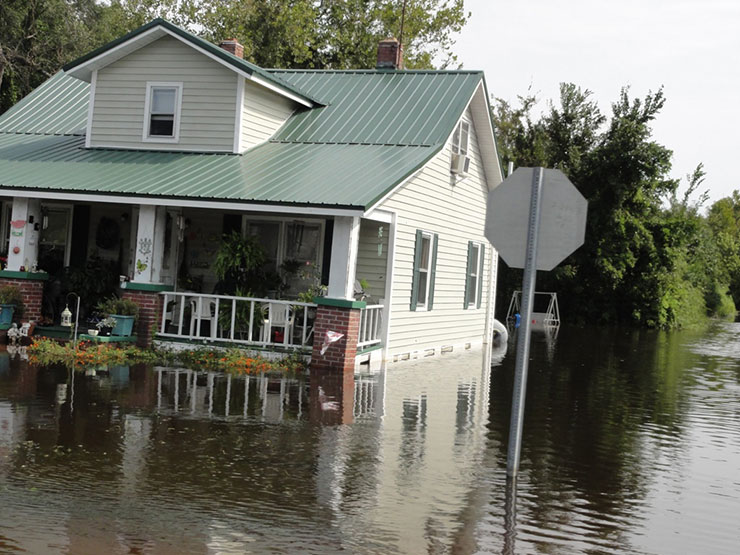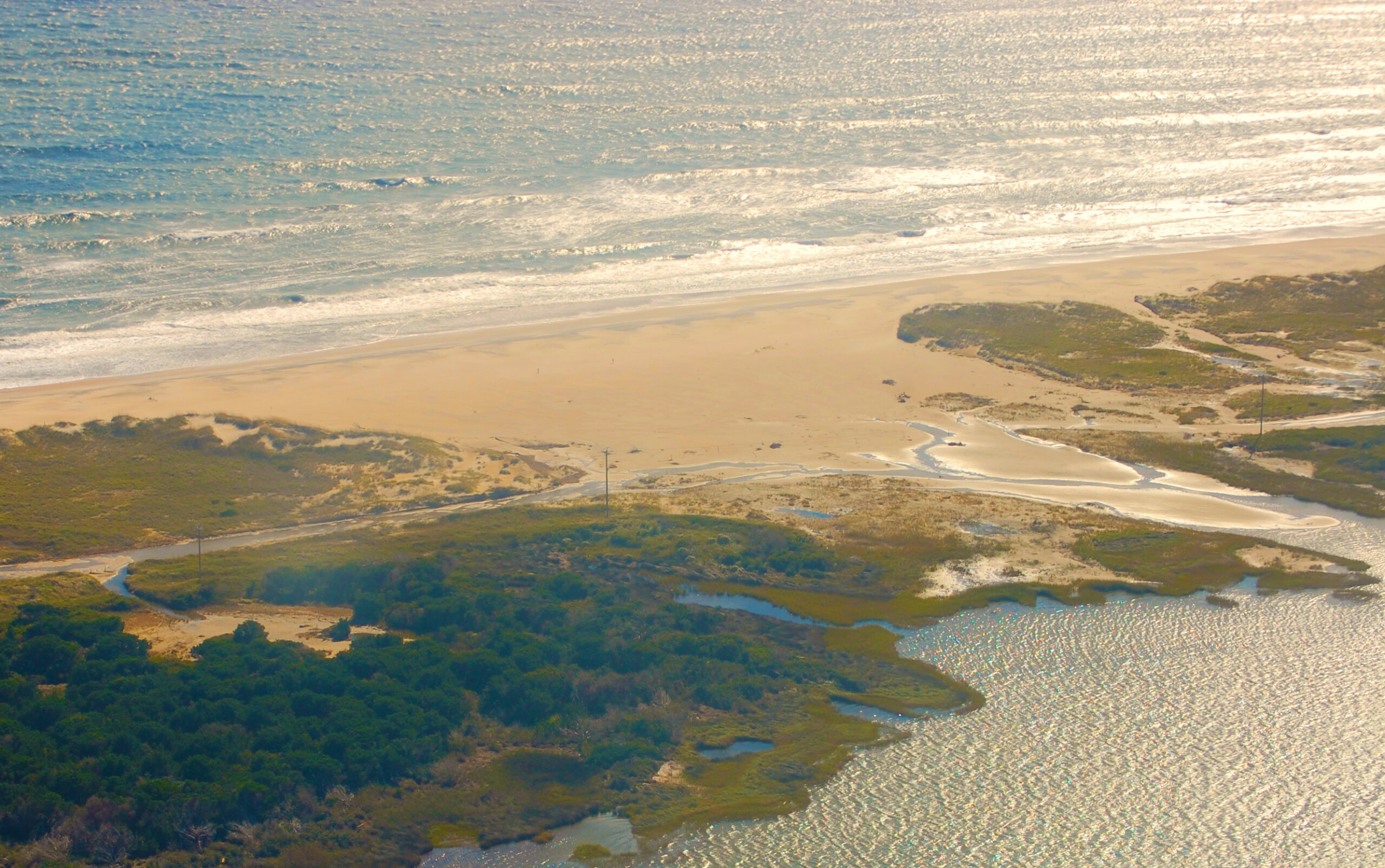Inner Banks Take a Beating: Storm Surge Surprised Many

The oceanfront areas were not the only ones affected by Irene. Jerry Allegood visits the Inner Banks, along the sounds and the rivers, and chronicles the destruction Irene left behind.
The water came surging out of the woods, over the farm fields and across the roads, encircling Michael Lewis’ home in rural Pamlico County in a white-capped cauldron that looked to him like the open waters of Pamlico Sound several miles away.
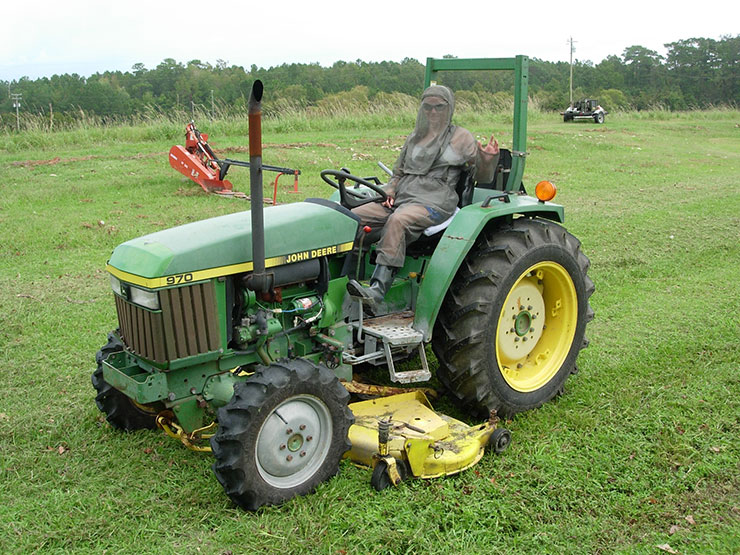
It kept on coming. Whipped by Hurricane Irene, water crept over the 4-foot-high foundation and climbed more than a foot inside. That was a first for the solid single-story house Lewis built in 1973. It had remained dry through a series of major storms — Hurricanes Bertha and Fran in 1996, Dennis and Floyd in 1999, and Isabel in 2003.
Lewis and other residents of Lowland, an aptly named community barely 3 feet above sea level, had weathered enough storms to know that Hurricane Irene might flood the shoreline and cause backwater creeks and ditches to overflow. But they did not expect flooding — what some locals call “tide” — to inundate homes, churches and business so far from the waterfront. Of the approximately 200 homes in Lowland, fewer than 10 escaped flooding, county officials say.
“I thought we were going to have some tide,” says Lewis, a 66-year-old carpenter, “but I didn’t think it was going to be this bad.”
UNEXPECTED FLOODING
The flooding from Hurricane Irene was a shock to thousands of people along the so-called Inner Banks, the mainland areas along rivers, creeks and sounds behind the state’s barrier islands. While the tourist-oriented Outer Banks incurred dramatic damage, including highly publicized washouts of N.C. 12 that cost the state millions of dollars to rebuild, inland communities suffered staggering losses spread over lesser-known roads. Storm-driven winds and water left mile after soggy mile of waterlogged homes, toppled trees, splintered docks and grounded boats.
In addition to property losses, Irene took a heavy toll on natural resources. State agencies said the storm caused $79.7 million in damage to timber and killed hundreds of thousands of game fish in major river systems.
Direction and duration were keys to Irene’s impact, not just wind speed.
Richard Bandy, meteorologist in charge of the National Weather Service office in Newport/Morehead City, says Irene wreaked havoc in mainland areas because it was large and slow moving. Prolonged winds blew down trees while pushing up a wall of water that reached 8 to 10 feet above ground level. He says the storm kept the waters not only higher, but for a longer period.
FISH GO BELLY UP
Torrential rains piled on more water, as much as 16 inches in some areas, according to the National Weather Service. Most inland rivers could accommodate the runoff because they were low from weeks of hot, dry summer weather. But rainfall brought another problem.
Chad Thomas, regional fishery supervisor for the N.C. Wildlife Resources Commission, says all that rain over a short period washed organic material and stagnant water containing little or no oxygen out of swamps and slow-moving creeks. As dissolved oxygen levels plummeted, he says, fish suffocated in vast stretches of rivers across Eastern North Carolina.
“It’s very widespread,” he says of the fish kill. “It’s very significant with regard to coastal fish populations.”
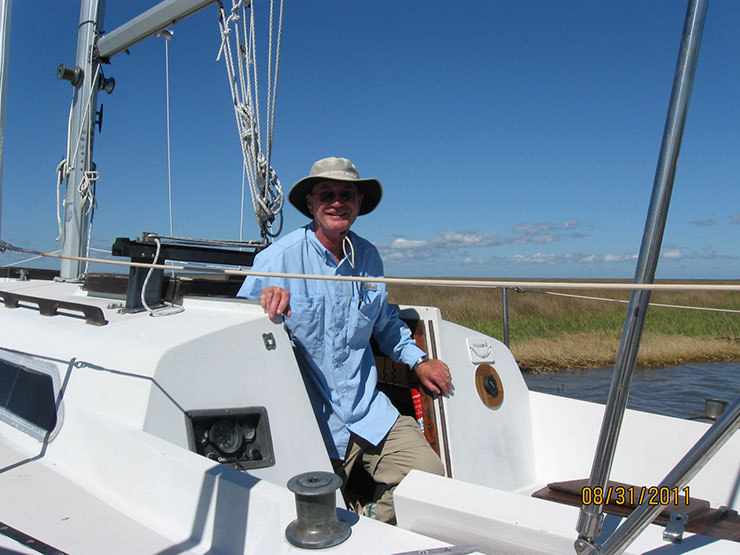
Within a few days, dead fish floated to the surface and smelly carcasses lined miles of shoreline. Thomas says larger fish succumbed first because they needed more oxygen, but smaller fish died as conditions continued. The silent slaughter included largemouth bass, crappie and bluegill bream — all popular game fish considered resident populations — and striped bass that migrated into the rivers. Catfish, carp and eel fared no better. Thomas says gar and bowrin (also known as blackfish or mudfish), two species usually not consumed and not as highly prized, can better withstand the low oxygen conditions.
Stricken fish created a sad sight on the Tar River in Greenville. Scores of gasping rockfish, catfish, sunfish and others schooled for a day or two in a flooded parking lot before sinking in the tea-black water.
In mid-September, the rivers experiencing low dissolved oxygen levels and fish kills included the Roanoke from Williamston downstream to Albemarle Sound, the Cashie, the Chowan from the North Carolina/Virginia state line to just north of Holiday Island near Edenton, and the Tar from Old Sparta to Washington. The same conditions were reported along the Neuse River from just below Kinston to New Bern, and around the Trent, New, White Oak, Newport and Scuppernong rivers.
Thomas says low oxygen levels persisted for about 20 days before conditions improved. Putting a number on the fish lost is difficult, he says, because so many died in out-of-the-way areas.
The bad news for anglers, he says, is that it will take at least three years for decimated fish populations to rebuild, and even longer to reach pre-storm levels.
PERFECT STORM FOR MOSQUITOES
While flooding killed fish, it created perfect spawning conditions for mosquitoes. Coastal counties cranked up aerial and ground spraying to combat hordes of blood-sucking pests that preyed on people forced to live in tents or open houses because of storm damage. Bryan Harris, environmental health supervisor in Pamlico County, says flooding created “a perfect storm as far as breeding mosquitoes.”
County workers gauge concentrations of mosquitoes by counting how many land on an open arm or piece of clothing in a minute. Ordinarily 20 per minute is considered a nuisance level. Harris cited mosquito counts in the low 40s, the 80s and at least 200 in some isolated areas including Goose Creek Island. “When you have 200-plus a minute, you just can’t keep up with the count,” he says.
The county stepped up spraying of insecticides to every other day in some places. Six weeks after the storm, repeated spraying and dry, cool weather brought some relief and conditions had improved, Harris says.
TREES GO DOWN
Wind and water combined to fell countless trees. Standing in soggy ground, even huge pines and oaks could not withstand hour after hour of wind gusting to hurricane strength. In residential areas as far inland as Roanoke Rapids, Kinston, Greenville and Goldsboro, hundreds of trees crashed down on houses and utility lines.
An aerial survey of timberland by the N.C. Division of Forest Resources a few days after the storm found an estimated 287,335 acres of timber in 18 counties sustained varying degrees of damage, most classified as light. That did not include downed trees in urban and residential areas or trees that may become damaged later by salt water from flooding.
While the losses are substantial, Irene didn’t come close to Hurricane Fran, which traveled farther inland, causing $1.25 billion worth of damage over 8 million acres of timberland in 1996. Hurricane Isabel racked up $565 million over 833,192 acres in 2003.
SURGING WATER
Bandy says some people may have underestimated the threat from the storm surge after Irene weakened near the North Carolina coast. The hurricane was downgraded from Category 3, with sustained winds from 111 to 130 miles an hour, to Category 1, with winds from 74 to 95 miles an hour. “Surge is one of the things you can’t associate with the category of the storm,” he says.
Tim Buck, Pamlico County manager, said the damages tab had already reached $70 million by late September. He agreed that people relaxed their guard after the storm was downgraded. “We all breathed a sigh of relief when we heard that forecast,” he says. But the storm’s slow crawl through Pamlico County “just brought the water in on us,” he adds.
As the hurricane passed over the coast, winds out of the east and southeast pushed water into the Neuse and Pamlico rivers with devastating results. Some waterfront homes in Pamlico and Beaufort counties were obliterated, leaving nothing but lumber piles and foundation blocks. Surviving structures had to be gutted because of initial water damage or mold. Jumbled piles of discarded furniture, mattresses, carpets and keepsakes lined roads weeks after the hurricane’s wind and water were long gone.
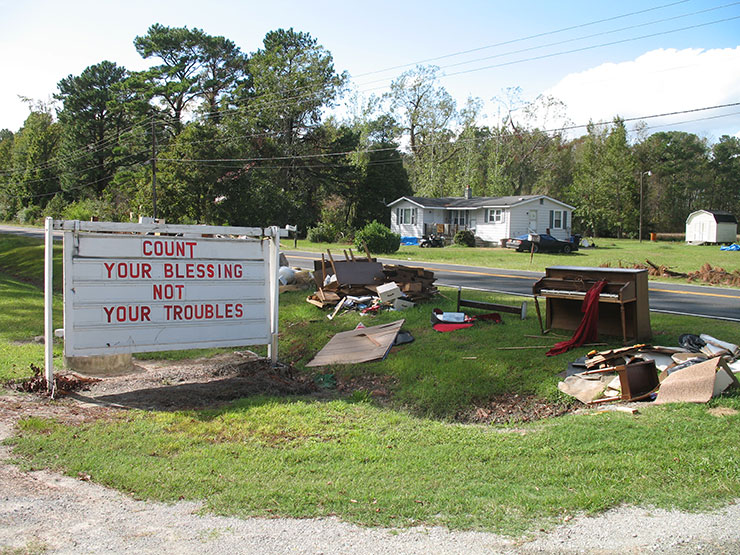
A ruined piano beside N.C. 304 stood as testament to the flooding at the tiny Church of God of Prophecy in Maribel in Pamlico County. The pulpit and pews were gone. Someone had salvaged guitars from the pile of discarded items. However, a sign out front conveyed the spirit of the small congregation: “Count your blessings, not your troubles.”
“We’re going to have church again pretty soon,” says Rev. Sheldon Russell, the church’s pastor, who was using his carpentry skills to gut and rebuild the sanctuary. He became pastor only a few weeks before the storm deposited more than 3 feet of water in the church and adjacent parsonage. Church members who lived in the area for more than 50 years say it was the first time the little white building was flooded.
The storm did not discriminate between mobile homes or mansions. Water swamped humble fish camps and gated communities. About 2,400 homes in Craven County were damaged to some degree, according to Stanley Kite, emergency services director. Kite says Irene was not the most powerful storm to hit the county, but it affected a wide array of people through flooding, downed trees and power loss.
At Fairfield Harbor in eastern Craven County, a private, upscale waterfront community with homes worth as much as $800,000, the storm damaged houses, boats and cars. “It was like a war zone,” recalled Mystre Van Horn, a community spokeswoman.
Trees fell on 300 homes, damaging about 100 badly enough to require new roofs. Van Horn said tree companies cut about 3,500 damaged and downed trees after the storm. Five to 10 damaged cars were hauled out every day for weeks.
Amid the devastation, there were odd quirks that brought a few chuckles.
A Fairfield Harbor resident, checking on his property after the storm, found a decorative concrete gnome and an angel perched on his boat dock. “He said, ‘I have no idea where they came from,'” Van Horn says. “I said, ‘Maybe they are good luck.'”
BOATS TAKE A BEATING
Boats tied to docks at piers and marinas broke free and wrought havoc. One large boat ended up high and dry, wedged between two large trees in a yard at Fairfield Harbor. A 38-foot sailboat came to rest atop a dock “sitting up there as pretty as you please,” says Van Horn.
Zan Monroe of New Bern thought he had securely anchored his 27-foot sailboat, Slow Motion, in Upper Broad Creek in Craven County, but Irene ripped the unmanned boat free. Monroe searched miles of waterway and was about to give up when a commercial fisherman in Hyde County called four days later. “He said, ‘I’m standing on your boat,'” Monroe recalls.
Slow Motion traveled about 75 miles north before coming to rest on Gibb Shoals Point near Engelhard, according to Monroe. The boat, which he says suffered only minor cosmetic damage, had to travel out of a creek and make a couple of sharp left turns on its voyage. Monroe retrieved the boat about three weeks later and sailed it home. “It had a happy ending all the way around,” he says.
Irene left one of the oddest storm spectacles at Broad Creek in Beaufort County where the 85-foot-long cruise boat, The Belle of Washington, snapped pilings, traveled about 200 feet along the shoreline and settled down on a homeowner’s pier. The 18-foot-wide boat perched precariously on the 4-foot-wide pier for more than a month before it was returned to its moorings. The sightseeing boat became a sight to see for curiosity seekers and news reporters.
“It was unbelievable,” says Tammy Swanner, a spokeswoman for the boat’s owners. “It looked like someone picked it up and put it right there. You could see the propeller.”
The Belle, which provides cruises on the Pamlico River around Washington, was relatively lucky. Other boats in the Broad Creek area were battered and sunk. “It looked like a kid who took his toy box and dumped it,” Swanner says.
In addition to hurricane winds and flooding, Irene spawned tornadoes in three areas. One twister heavily damaged an auto dealership near Belhaven. Another struck a grain silo and hardware store near Creswell. A tornado touched down near Columbia, destroying nine homes. Floodwater ran into Tyrrell County offices in Columbia and also caused $3 million in damages to schools that will have to be replaced. “It would cost more to fix it than to replace the schools,” notes Tyrrell County Manager Willie Carawan.
The National Weather Service estimates that storm surge along Pamlico Sound and the Pamlico River reached 7 to 10 feet. Homes were heavily damaged or completely washed away in several communities, including Jarvis Landing and Hickory Point.
Carolina Seafood Co., a crab-picking and processing plant near Aurora, took a beating from water on one side and floating debris on the other. Huge trees became battering rams, knocking down concrete walls. The storm put 4 feet of water inside the plant and destroyed the room where 18 women normally pick meat from cooked crabs. The jobs of the pickers and several other employees were gone with the wind and water.
Despite the damage at the family business that has operated since 1964, owner Vann Henries says he was lucky his home was not damaged, unlike the homes of many neighbors. “I can leave this nightmare and go home and put my head on a pillow,” he says.
COMING BACK
Irene also walloped North Carolina State University’s Pamlico Aquaculture Field Laboratory at Aurora, where researchers study hybrid striped bass and other estuarine and marine fisheries. North Carolina Sea Grant supported the pioneering work to commercially produce hybrid striped bass in North Carolina farm ponds in the late 1980s. Researchers have selectively bred and domesticated generations of striped bass and white bass at this facility for more than two decades.
The surge at Hickory Point on the Pamlico River demolished a dormitory, office and pier, and ruined heat pumps that control temperature for the fish breeding. Thousands of fish died but surprisingly, most of the broodstock survived.
Craig Sullivan, a North Carolina Sea Grant researcher who has worked at the facility for 25 years, was pleased that the fish were OK, but still felt the loss personally. Asked what he thought when he first viewed the facility after the storm, he paused. “I bred those fish with my own hands,” he says. “I can’t even talk about it.”
Sullivan helped other employees with cleanup and repair, spending some nights in a tent until he could move up to a camper trailer. The physical labor was more demanding than classroom teaching for Sullivan, who says he felt as if he had been “mugged by Irene.”
He plans to breed fish this spring as the facility has done for the last quarter-century. “There’s one point to be made,” he says with emphasis. “We’re still in the game.”
And so is Carolina Seafood Co. Henries plans to rebuild the business his grandfather started and his father passed to him. “We’re going to need some help,” he says, “and I don’t like asking for help.”
Initially, the company could not steam or pick meat from crabs because of equipment damage, so Henries was only dealing with live crabs. After cleaning and salvaging some equipment that had washed out, he has part of the business going again.
“We went out to the woods and got two of our cull tables back and fixed them up,” Henries says. “We’re back to buying crabs.”
This article was published in the Holiday 2011 issue of Coastwatch.
For contact information and reprint requests, visit ncseagrant.ncsu.edu/coastwatch/contact/.
- Categories:
